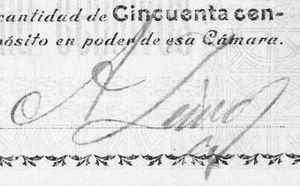Cámaras Nacionales
 A couple of Chambers of Commerce issued cheques to alleviate the shortage of small change during the revolution.
A couple of Chambers of Commerce issued cheques to alleviate the shortage of small change during the revolution.
Campeche

 M861 50c Cámara Agrícola Nacional de Campeche
M861 50c Cámara Agrícola Nacional de Campeche

 M857 5c Cámara Agrícola Nacional de Campeche
M857 5c Cámara Agrícola Nacional de Campeche

 M857 5c Cámara Agrícola Nacional de Campeche
M857 5c Cámara Agrícola Nacional de Campeche

 M858 10c Cámara Agrícola Nacional de Campeche
M858 10c Cámara Agrícola Nacional de Campeche

 M859 25c Cámara Agrícola Nacional de Campeche
M859 25c Cámara Agrícola Nacional de Campeche

 M860 50c Cámara Agrícola Nacional de Campeche
M860 50c Cámara Agrícola Nacional de Campeche
The Cámara Agrícola Nacional de Campeche produced two series of cheques, printed by a local firm, Imprenta de Joaquín Castro. These were issued by different businesses that had deposited a sum to guarantee them with the Cámara. They had a distinguishing series and signature on the face and the printed signatures of Manuel García Gual as Presidente, G. J[ ][identification needed] as Tesorero, and [ ][identification needed] (or, for the second issue, Eduardo Alfaro Lara) as Secretario of the Cámara on the reverse.
|
Manuel García Gual was the brother of sometime interim governor José García Gual. He was the manager of the Campeche branch of the Banco Yucateco when it opened on 1 January 1898El Correo Español, Tomo 12, Año 12, Núm. 2,291, 12 January 1898. |
 |
| G. J[ ] |  |
|
Eduardo Alfaro Lara was born in Campeche in 1870. He was a businessman, a member of the board of the local branch of the Banco Peninsular serving as secretary in 1908El Diario, vol. VI, núm. 790, 12 December 1908 and as substitute for Manuel García Gual as director in October 1909El Diario, vol. VI, núm. 1,074, 1 October 1909, and in December 1914 was appointed local agent for the Comisión Reguladora de HenequénEl Pueblo, Año I, Tomo I, Núm. 81, 27 December 1914. He also served as a state deputy in 1910. He died in Mexico City on 11 January 1934.
|
 |
| M. Cambranis |  |
| D. Hurtado |  |
| Vicente Gómez Hernández |  |
| [identification needed] |  |
Known examples are a 50c cheque dated 22 November 1913 and a series of cheques (5c, 10c, 25c and 50c) dated 20 May 1914.
| Date on note | denom. | Series | from | to | total number |
total value |
|
| 22 November 1913 | 5c | ||||||
| 10c | |||||||
| 25c | |||||||
| 50c | includes number 001569 | ||||||
| 20 May 1914 | 5c | M.R.R. | unnumbered | signed by D. Hurtado | |||
| C.M. | unnumbered | with datestamp of Vicente Gómez Hernández, 8 June 1914 | |||||
| 10c | N.R.A. | unnumbered | signed by M. Gual | ||||
| 25c | M.R.R. | unnumbered | signed by D. Hurtado | ||||
| 50c | N. RO. | unnumbered | |||||
| $34,792 | |||||||
This was during the Huertista governorship of Manuel Rivera, who had the support of the members of the Cámara Agrícola Nacional as he could maintain order after the upset of Madero.
On 2 February 1914 an editorial in El Diario on the problem of small change reported that it had received letters from Campeche and Ciudad del Carmen about the lack of small change and the depreciation of the vales issued to address itEl Diario, Año. VII, núm. 2,127, 2 February 1914.
It appears that the two issues had a combined total of $34,792, of which $2,525 was never put into circulationPeriódico Oficial, Año XXXIII, Núm. 2901, 21 September 1915.
These notes were withdrawn once the Constitutionalists had taken over and introduced their own currency. In September 1915 the Jefe de Hacienda reported that the Banco Peninsular Mexicano had taken in $11,656 and his own Jefatura had collected $19,034. These, together with the unissued $2,525, making a grand total of $33,215, were incinerated in the patio of the Aduana Marítima on 13 September 1915ibid.. So $1,577 was still outstanding.
Ciudad del Carmen
Ciudad del Carmen is a city in the southwest of the state.
On 7 April 1913 Admiral Caperton reported to the Navy Department on the “invalidation of certain issues of bills signed by Leguna de Terminos”SD papers, 812.515/38; 812.00/14812. This presumably refers to a Ciudad de Carmen issue: Laguna de Terminos is the lagoon behind Ciudad de Carmen.
On 2 February 1914 an editorial in El Diario on the problem of small change reported that it had received letters from Campeche and Ciudad del Carmen about the lack of small change and the depreciation of the vales issued to address itEl Diario, Año. VII, núm. 2,127, 2 February 1914.
 M865 50c Cámara Nacional de Comercio
M865 50c Cámara Nacional de Comercio
| Date on note | denom. | Series | from | to | total number |
total value |
|
| 50c | A | signed by A. Zeind | |||||
The Cámara Nacional de Comercio in Ciudad del Carmen made a similar issue to the Campeche one. The known example is a 50c cheque, from Alejandro Zeind, dated 16 July 1914.
| Alejandro Zeind |  |
